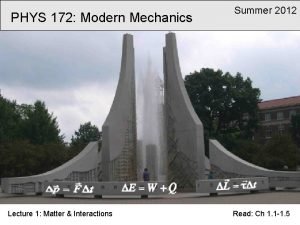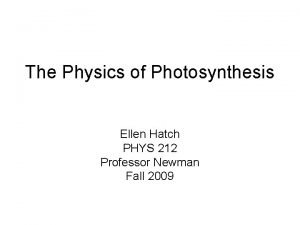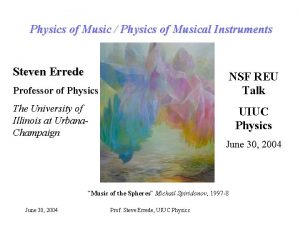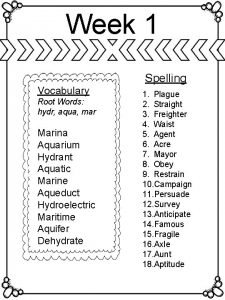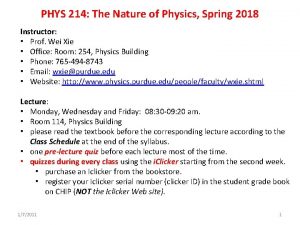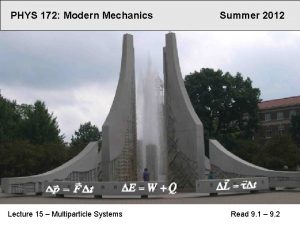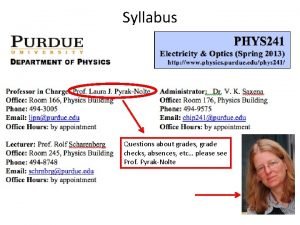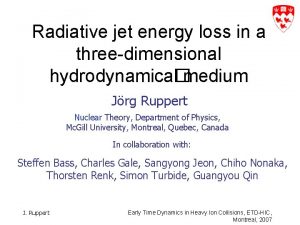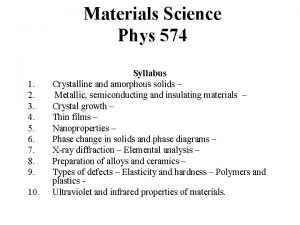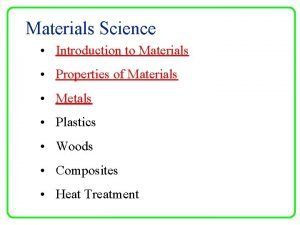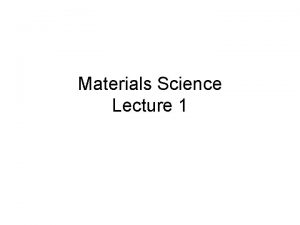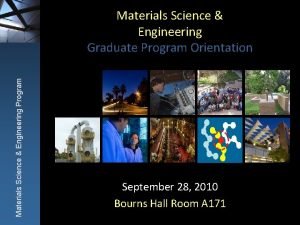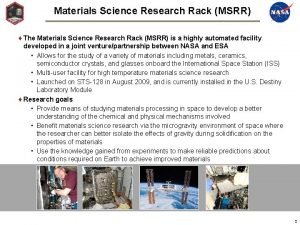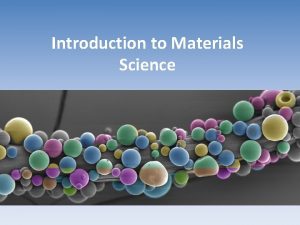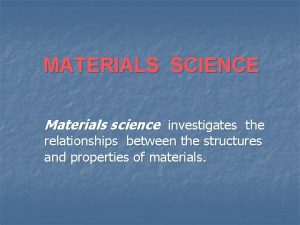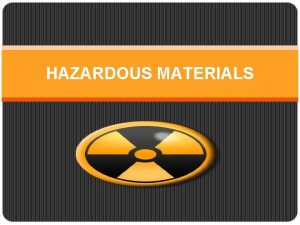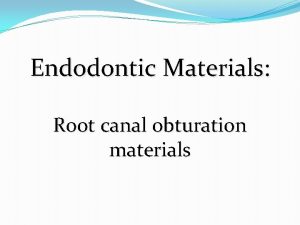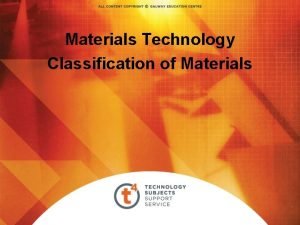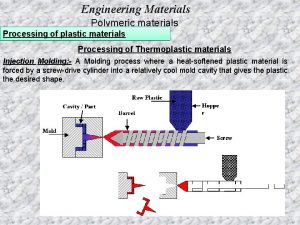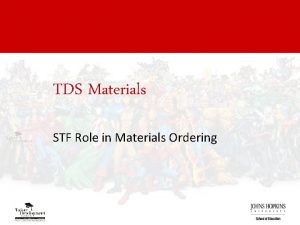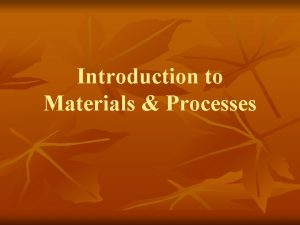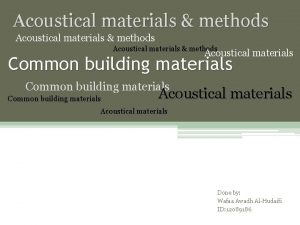Materials Science Phys 574 1 2 3 4
































- Slides: 32

Materials Science Phys 574 1. 2. 3. 4. 5. 6. 7. 8. 9. 10. Syllabus Crystalline and amorphous solids – Metallic, semiconducting and insulating materials – Crystal growth – Thin films – Nanoproperties – Phase change in solids and phase diagrams – X-ray diffraction – Elemental analysis – Preparation of alloys and ceramics – Types of defects – Elasticity and hardness – Polymers and plastics Ultraviolet and infrared properties of materials.

Our Text Book: 1. Material Science and Engineering : An Introduction by William D. Callister, Jr Seventh Edition, John Wiley & Sons, Inc. 2. Material Science and Engineering A first Course: Fifth Edition by V Raghavan PHI

Exam and Grading: 1. Homework: 20% 2. Two one and half hour tests: 40 % 3. The final exam: 40%

Historical Perspective • Beginning of the Material Science - People began to make tools from stone – Start of the Stone Age about two million years ago. Natural materials: stone, wood, clay, skins, etc. • The Stone Age ended about 5000 years ago with introduction of Bronze in the Far East. Bronze is an alloy (a metal made up of more than one element), copper + < 25% of tin + other elements. Bronze: can be hammered or cast into a variety of shapes, can be made harder by alloying, corrode only slowly after a surface oxide film forms. • The Iron Age began about 3000 years ago and continues today. Use of iron and steel, a stronger and cheaper material changed drastically daily life of a common person. • Age of Advanced materials: throughout the Iron Age many new types of materials have been introduced (ceramic, semiconductors, polymers, composites…). Understanding of the relationship among structure, properties, processing, and performance of materials. Intelligent design of 4 new materials.

Introduction To Materials Science, Chapter 1, Introduction History of Materials Science & Engineering • materials closely connected our culture • the development and advancement of societies are dependent on the available materials and their use • early civilizations designated by level of materials development • initially natural materials • develop techniques to produce materials with superior qualities (heat treatments and addition of other substances) University of Virginia, Dept. of Materials Science and Engineering

Introduction To Materials Science, Chapter 1, Introduction A better understanding of structure-composition-properties relations has lead to a remarkable progress in properties of materials. Example is the dramatic progress in the strength to density ratio of materials, that resulted in a wide variety of new products, from dental materials to tennis racquets. University of Virginia, Dept. of Materials Science and Engineering 6

Introduction To Materials Science, Chapter 1, Introduction Materials Science The discipline of investigating the relationships that exist between the structures and properties of materials. Materials Engineering The discipline of designing or engineering the structure of a material to produce a predetermined set of properties based on established structure-property correlation. University of Virginia, Dept. of Materials Science and Engineering 7

Introduction To Materials Science, Chapter 1, Introduction Four Major Components of Material Science and Engineering: Structure of Materials Properties of Materials Processing of Materials Performance of Materials University of Virginia, Dept. of Materials Science and Engineering 8

Introduction To Materials Science, Chapter 1, Introduction Classification of Materials Metals Ceramics & Glasses Polymers • good conductors of electricity and heat • lustrous appearance • susceptible to corrosion • strong, but deformable • thermally and electrically insulating • resistant to high temperatures and harsh environments • hard, but brittle • very large molecules • low density, low weight • maybe extremely flexible Models. Dept. & Materials University of Virginia, of Materials Science and Engineering July

Introduction To Materials Science, Chapter 1, Introduction Classification of Materials: A Few Additional Catagories Biomaterials Semiconductors Composites • implanted in human body • compatible with body tissues • electrical properties between conductors and insulators • electrical properties can be precisely controlled • consist of more than one material type • designed to display a combination of properties of each component hip replacement Intel Pentium 4 fiberglass surfboards Models. Dept. & Materials University of Virginia, of Materials Science and Engineering July

Introduction To Materials Science, Chapter 1, Introduction Doing Materials! • Engineered Materials are a function of: – Raw Materials Elemental Control – Processing History • Our Role in Engineering Materials then is to understand the application and specify the appropriate material to do the job as a function of: – – – Strength: yield and ultimate Ductility, flexibility Weight/density Working Environment Cost: Lifecycle expenses, Environmental impact* * Economic and Environmental Factors often are the most important when making the final decision! University of Virginia, Dept. of Materials Science and Engineering

Introduction To Materials Science, Chapter 1, Introduction Overview: Amorphous and crystalline solid states. States of matter. General description. A vapor (or gas) needs a completely enclosed container to have a definite volume; it will readily take on any shape imposed. Liquids have definite volume but will change shape under an arbitrarily small force (e. g. their own weight). Solids have a definite volume and change shape especially irreversibly) only under considerable force. University of Virginia, Dept. of Materials Science and Engineering 12

Introduction To Materials Science, Chapter 1, Introduction Engineering considerations. Certain kinds of materials do not lend themselves to such a simple classification. �� Window glass flows like a liquid over extended periods of time even at room temperature. �� Polymer melts which are treated very much like liquids in ordinary processing operations in fact have many of the properties of solids when deformed at high rates. The explanation for the different behavior of these materials lies in a more detailed analysis of the structures involved. University of Virginia, Dept. of Materials Science and Engineering 13

Introduction To Materials Science, Chapter 1, Introduction Materials that really behave as solids (i. e. , do not change shape under arbitrarily small forces over even infinitely long times) have a perfect crystalline structure in which no defects or noncrystalline regions are present. �� Materials that behave like solids, but only over the short term, can undergo structural rearrangements that occur very slowly. Example: in the case of polymers, motions of very large segments are required to change molecular conformations to achieve shape changes. Often molecular rearrangement is slow because the temperature is too low University of Virginia, Dept. of Materials Science and Engineering 14

Introduction To Materials Science, Chapter 1, Introduction Many of these types of substances are amorphous or have significant amorphous content within them. However, liquids are amorphous and structural rearrangements can take place on a scale very fast compared to most experimental time scales. Therefore the essence of solid and liquid like character is more easily distinguished on the basis of structure. University of Virginia, Dept. of Materials Science and Engineering 15

Introduction To Materials Science, Chapter 1, Introduction True solids are crystalline, i. e. , they have regular arrangements of atoms or groupings of atoms in a lattice. True liquids are amorphous, i. e. the relative positions of the atoms or molecules are not correlated except perhaps for nearest neighbors. However, their density is quite high often only 1020% lower than that of the solid formed from the same atoms or molecules. In addition, thermal energy is high enough to continuously shuffle the arrangement of the atoms or molecules. University of Virginia, Dept. of Materials Science and Engineering 16

Introduction To Materials Science, Chapter 1, Introduction Amorphous “solids” have the structure of liquids, but this is frozen in” at low temperatures so that structural changes cannot occur quickly enough on ordinary time scales to produce liquid behavior. Liquid crystalline materials behave very much like a liquid in their flow behavior but have some elements or ordering associated with their structure. These materials do not possess 3 -dimensional order but (probably) only rotational order associated with asymmetric molecules. In the gas state, molecules are almost entirely free of the influence of other molecules; there is virtually no structure and the densities are very low. University of Virginia, Dept. of Materials Science and Engineering 17

Introduction To Materials Science, Chapter 1, Introduction On the basis of the above discussion, a reasonable classification can be made as follows: �� A solid is a material that conforms to the "everyday" concept of a solid; it should always be stated whether we are dealing with a crystalline or an amorphous material. This will correspond closely with the stricter definition involving a solid as a material that has been cooled to below its crystallization temperature (crystallizable materials) or its glass formation temperature (for glass forming solids) �� Similarly, a liquid material corresponds to the “everyday” concept of a liquid whereby the material changes shape readily under very small forces. This is in reasonable agreement with the stricter definition of a liquid as a material that is above its crystallization or glass formation temperature. �� The gas or vapor state is the simplest to comprehend and treat scientifically; however, it plays the least role in materials science. For many materials, e. g. all polymers, the gas state cannot be reached because the substance decomposes before temperatures high enough for the vapor state can be achieved. Liquid crystalline materials must be considered as a separate entity University of Virginia, Dept. of Materials Science and Engineering 18

Introduction To Materials Science, Chapter 1, Introduction Solid Materials: basic concepts of crystallization, glass formation and melting. Assumptions. q One-component systems (therefore alloys, blends, etc. ) are excluded for the present. q Materials can exist at sufficiently high enough temperatures as liquids (melts) q without any long-range order. There are important classes of materials that never involve an equilibrium melt during their formation process. q An important example is epoxy resins that are synthesized directly into a (glassy) solid state during the curing or hardening reaction. q The melt is the only state of matter (other than the gas) in which materials exist in a state of thermodynamic equilibrium. q Whenever a material is reheated into the melt region, it reaches the same state depending upon only temperature, pressure and possibly other state variables (if no chemical changes have occurred). q As the material is cooled, a number of changes may occur which allow classification of the material at the lower temperature. q Additional information can be obtained by re-heating the material into the melt state. University of Virginia, Dept. of Materials Science and Engineering 19

Introduction To Materials Science, Chapter 1, Introduction Techniques for studying the solid – liquid transition. Dilatometry. The volume is measured as a function of temperature. Measuring the linear dimensions is not suitable if liquids are involved since the linear dimension can change without a change in the volume. Differential Thermal Analysis (DTA) and Differential Scanning Calorimetry (DSC). A sample and an inert reference material are placed symmetrically inside a furnace in which the temperature is changed linearly with time. In one method (DTA) the temperature difference between the sample and reference is measured and recorded directly as a function of the sample temperature. If both the reference and sample have the same specific heat, the temperature difference will be zero between sample and reference. If both the reference and sample have different specific heat values, a temperature difference (representative of the specific heat) will be measured. When a sample undergoes any kind of transformation that uses or emits energy (heat), the temperature difference between the sample and reference will change further. University of Virginia, Dept. of Materials Science and Engineering 20

Differential Scanning calorimetry (DSC) • In the other method Differential Scanning calorimetry (DSC) special circuitry keeps the temperature difference at a value of zero by means of small heaters under the sample and reference material. • The thermal analysis signal in this case is the power required to maintain a zero temperature difference. • It reflects the specific heat of the sample and any heats of transformation just as in the DTA method. • In the discussion that follows, thermal analysis signal is either the temperature difference (DTA) or the power required for a zero difference (DSC).

DTA

DSC

• With suitable calibration, the area under a signal peak is proportional to the enthalpy change involved. • Except for the aforementioned differences, the signals appear very similar and both have the same capability of being interpreted quantitatively.

Transitional behavior. • Crystallization temperature (TC) • The most common behavior observed is that the material will crystallize at a particular temperature (Tc) when cooled from the melt. The value of Tc will depend significantly upon the cooling rate (decreasing as cooling rate increases) as well as external factors including the presence of nucleating agents or other crystallization promoters.

Melting Point Tm When a sample is reheated from the crystalline state, it will lose the Crystalline order at the melting point Tm. Tm is always higher than Tc; the difference is identified as the super-cooling interval.

There is a volume discontinuity (usually a decrease) during the crystallization transition.

• The thermal analysis signal indicates the presence of a heat of crystallization (exothermic). • On melting there is an endothermic heat of fusion.

Tm is more fundamental and reproducible than Tc. The magnitude of the supercooling effect is (Tm – Tc). Hg 77 C Au 230 C Co 330 C H 2 O 39 C Ga 29 C Semi – crystalline polymers 50 C Some melts will not crystallize even though they are cooled very slowly. These are intrinsically glassforming materials.

• Generally, they will not crystallize because they are very irregular from a structural point of view, i. e. it is impossible to fit their molecules into a lattice. • Many polymers fall into this category. • Other materials have melts that could potentially crystallize. • These will do so only if the cooling rate is slow enough to give them time to rearrange their structure. • If the cooling rate is too high, they will form glasses.

Glass transition Representative dilatometric and thermal analysis results for these materials would have the following characteristics: The volume has no discontinuity at the glass formation temperature but a change in slope. Similarly, thermal analysis signal shows a step change in specific heat. This behavior for the primary (V) and secondary (Cp) thermodynamic quantities defines the transition as a second order thermodynamic transition.

The glassy state is not a thermodynamic equilibrium state: it is very dependent upon formation history including cooling rate, pressure, etc. The exact nature of the glass transition is somewhat controversial: although it is not a 2 nd order transition in the sense of Ehrenfest*, phenomenologically it appears as a 2 nd order transition
 Place value representations
Place value representations 574-173-443
574-173-443 What is your favorite lesson
What is your favorite lesson Phys 102 uiuc
Phys 102 uiuc Uiuc physics 101
Uiuc physics 101 Phys courses ucsd
Phys courses ucsd How to calculate percent difference
How to calculate percent difference Purdue physics 172 past exams
Purdue physics 172 past exams Purdue phys 241
Purdue phys 241 Http //www.phys.hawaii.edu/ teb/optics/java/slitdiffr/
Http //www.phys.hawaii.edu/ teb/optics/java/slitdiffr/ Wave optics topics
Wave optics topics Phys 212 equation sheet
Phys 212 equation sheet Phys 398 uiuc
Phys 398 uiuc Purdue phys 272
Purdue phys 272 In the term antipyretic the root pyret means
In the term antipyretic the root pyret means Hydr root words
Hydr root words Phys 271
Phys 271 Phys 214
Phys 214 Phys 172
Phys 172 Phys 121 umd
Phys 121 umd Eosc 111 ubc
Eosc 111 ubc Phys 375
Phys 375 Physics 101 uiuc
Physics 101 uiuc Phys 225
Phys 225 Phys140
Phys140 Phys 244
Phys 244 Purdue phys 241
Purdue phys 241 Chiho nonaka
Chiho nonaka Quantumi
Quantumi Subtle
Subtle Phys 214
Phys 214 Phys 214
Phys 214 Phys courses ucsd
Phys courses ucsd







